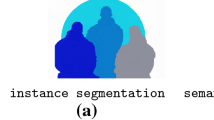Abstract
In this article we generalise some of the existing model selection criteria used in statistics and computer vision. Model selection criteria are mostly used to decide which model is more appropriate for explaining a specific data set. We adapt these criteria in a way that they can be used for the evaluation of models fitted to different data sets and for the evaluation of sets of models. We found this adaption especially useful in situations where we have a set of models with domains that may overlap and where we need to find an optimal subset of models for explaining the whole data set. Adapted model selection criteria were then succesfully used in range image segmentation application (reverse engineering), based on the recover-and-select paradigm.














Similar content being viewed by others
References
Bajcsy R, Lee SW, Leonardis A (1996) Detection of diffuse and specular interface reflections and inter-reflections by color image segmentation. Int J Comp Vis 17:241–272
Xu L, Jackowski M, Goshtasby A, Yu C, Roseman D, Bines S, Dhawan A, Huntley A (1999) Segmentation of skin cancer images. Imag Vis Comp 17(1):65–74
Lukäcs G, Marshall AD, Martin RR (1998) Faithful least-squares fitting of spheres, cylinders, cones and tori for reliable segmentation. In: Proceedings of the 5th European Conference on Computer Vision, Freiburg, Germany, June 1998
Leonardis A, Gupta A, Bajcsy R (1995) Segmentation of range images as the search for geometric parametric models. Int J Comp Vis 14:253–277
Bolles RC, Fischer MA (1981) A RANSAC-based approach to model fitting and its applications to finding cylinders in range data. IJCAI 637–643
Besl PJ, Jain RC (1988) Segmentation through variable-order surface fitting. IEEE Trans PAMI 10:167–192
Akaike H (1973) Information theory and an extension of the maximum likelihood principle. In: Petrov BN, Csaki F (eds) 2nd international Symposium of Information Theory
Kanatani K (1998) Geometric information criterion for model selection. Int J Comp Vis 26(3):171–189
Bozdogan H (1987) Model selection and Akaike”s information criterion (AIC): the general theory and its analytical extensions. Psychometrika 52:345–370
Rissanen J (1978) Modelling by shortest data description. Automatica 14:468–471
Schwarz G (1978) Estimating the dimension of the model. Annal Stat 6:461–464
Jakli A, Leonardis A, Solina F (1996) Segmentor: an object-oriented framework for image segmentation. In: Proceedings of the 3rd Slovenian-German and the 2nd SDRV Workshop, Ljubljana, Slovenia, April 1996
Boyer KL, Mirza MJ, Ganguly G (1994) The robust sequential estimator: a general approach and its applications to surface organization in range data. IEEE Patt Anal Mach Intell 16(10):987–1001
Leclerc YG (1989) Constructing simple stable descriptions for image partitioning. Int J Comp Vis 3(1):73–102
Bubna K, Stewart CV (1998) Model selection and surface merging in reconstruction algorithms. In: Proceedings of the International Conference on Computer Vision, Bombay, India, January 1998
Bubna K, Stewart CV (2000) Model selection techniques and merging rules for range data segmentation algorithms. Comp Vis Imag Underst 80:215–245
Kverh B (2001) Selection of parametric models in data segmentation framework. Dissertation, University of Ljubljana
Jakli A (1997) Construction of CAD models from range images. Dissertation, University of Ljubljana
Leonardis A, Jakli A, Solina F (1997) Superquadrics for segmenting and modeling range data. IEEE Trans PAMI 9(11):1289–1295
Glover F, Laguna M (1997) Tabu search. Kluwer, Boston, MA
Hoover A, Jean-Baptiste G, Jiang X, Flynn PJ, Bunke H, Goldgof DB, Bowyer K, Eggert DW, Fitzgibbon A, Fisher RB (1996) An experimental comparison of range image segmentation algorithms. IEEE Trans PAMI 18(7):673–689
Efron B, Tibshirani R (1993) An Introduction to Bootstrap. Chapman-Hall, New York
Solina F, Leonardis A (1998) Proper scale for modeling visual data. Imag Vis Comp 16:89–98
Author information
Authors and Affiliations
Corresponding author
Rights and permissions
About this article
Cite this article
Kverh, B., Leonardis, A. A generalisation of model selection criteria. Pattern Anal Applic 7, 51–65 (2004). https://doi.org/10.1007/s10044-004-0206-5
Received:
Accepted:
Published:
Issue Date:
DOI: https://doi.org/10.1007/s10044-004-0206-5




